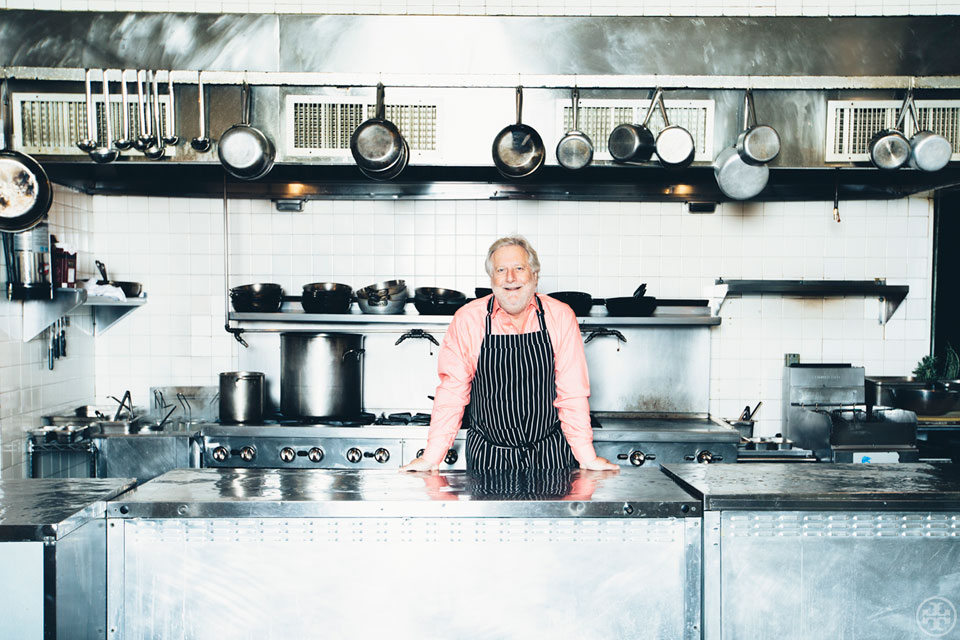
When we last saw Barbuto Chef Jonathan Waxman, at our Tastemaker Roundtable, he was telling us about his early days as a trombone musician before, stranded in Hawaii on a gig, he became a busboy at the local Rusty Harpoon. A year later, we catch up with the culinary legend, who fills us in on the rest of the story and what really got the cooking career going. Plus, discover why you should never be insulted if he turns down your invitation to brunch.
Of Cattle & Crustaceans
I grew up on a farm. My grandfather would show me the steer being slaughtered and I’d be scared to death looking at this carcass. I had nightmares for years afterwards, but that really helped me as a cook. It helped me because I understood what it takes to be a farmer, what it takes to raise something from a small calf to a 1500-pound beast. Today, a lot of chefs don’t have that connection yet. I remember being in Nova Scotia on one of those lobster boats… and that there is one of the most dangerous occupations in the world. Chefs in New York will get a box of lobsters delivered to their door — they have no relationship to the intensity the job entails.
Before Alpha Chef, Alfa Romeos
After working at the Rusty Harpoon [read the story here], I came back to Berkeley, California, and sold Ferraris and Alfa Romeos. The wife of the dealership owner was a big foodie and said I should go to cooking school at Tante Marie’s in San Francisco. So I went and fell in love with cooking. [The owner Mary Risley] said I should become a chef. I said, “What’s that? Someone who goes to Sizzlers and cooks steaks?” She goes, “No, a chef like in France.” She helped me sign up for La Varenne [cooking school] in Paris. So at age 25, November 1976, I land there. I didn’t speak a word of French so I went to Alliance Française. The guy next to me was Chuck Baker, a fashion photographer for The New York Times. I lived in a house with him and all these models.
Beluga Bait & Alice Waters, Professional Sweet-Talker
I worked for Alice Waters in the mid-Seventies, at Chez Panisse. At the time, there were three people on the line: Jean-Pierre Moullé, Alice Waters and me, and that was it. We used to do 120 covers a day. It was the greatest in the world, but it was so, so hard. You have no idea. Because Alice wouldn’t give us the menus until the Thursday of the week before. It was freeform — she took from cookbooks, from markets, whatever whimsy she decided on. We would nervously pick up the menus on Thursday and go, “Holy s—, really?” It was a great learning experience but also a complete nightmare every time.
I remember one night, a Saturday night, we’d just done 120 covers and it had gone really well. I was exhausted and Alice did one of those things where she winked at me and said, “Come here, honey. We got the lamb in for next week’s menu… They need to be broken down.” I said, “Alice, it’s one o’clock in the morning. I can’t do it.” She started stroking my arm and goes, “Yes, you can.” And she turned around and made me a little blini and put on enough caviar to choke a horse, and then covered it in butter. Before I could say anything, she shoved it in my mouth — I’ve got butter dripping on me, I’ve got caviar on me — and handed me a glass of ’62 Krug. I said, “Ok, I’m in.”
It’s OK, Hitchcock Hated Them Too
The reason I really hate brunch is that I really hated eggs as a kid. My grandmother used to make me polish the eggs before they went to market — that was part of the problem. And I really had this aversion to a fried egg staring me in the face. The only egg I did like was my father’s lox-and-onion scrambled eggs. He would burn the crap out of it for me and I loved that. A whole meal centered around eggs, to me, is a little silly. There’s breakfast and then there’s lunch, but somehow they had sex and made brunch.
